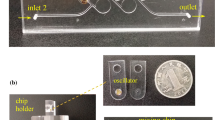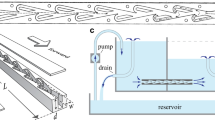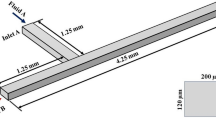Abstract
In this study, active mixing in diverging microchannels is investigated experimentally. Using a custom-built dynamic pressure generator as the actuation source, the influences of the half-angle of the diverging section and the phase difference of the two actuating pressures in mixing performance are explored. Two flow characteristics, hydrodynamic instability and fluid lamellae, are identified as the main mechanisms leading to mixing enhancement. Even at very low Reynolds numbers, flow instability occurs in large half-angle diverging micromixers. The resulting tendril structures provide extra stretching and folding of the interface, and the degree of mixing increases accordingly. Nevertheless, flow instability alone is insufficient. To achieve excellent mixing in the diverging microchannels, the presence of both mechanisms is necessary. While pulsatile pressures vary in-phase, incoming streams flow collaterally and there is no fluid lamella effect. The concentration field is highly inhomogeneous even though tendril structures appear near the throat. In contrast, flow remains quite stable under anti-phase actuation. Fluid flows reciprocally between the two upstream branches during more than three quarters of a cycle, and patterns a series of fluorescence bands. Mixing is limited to molecular diffusion and performs poorly. When the phase difference shifts away from 0 and π, mixing performance improves significantly. To obtain the best results, a phase difference between 0.25π and 0.5π (or 1.5π and 1.75π) and a diverging micromixer with a large half-angle are preferred.











Similar content being viewed by others
References
Bilenberg B, Rasmussen T, Balslev S, Kristensen A (2006) Real-time tunability of chip-based light source enabled by microfluidic mixing. J Appl Phys 99:023102-1-023102-5
Bottausci F, Mezić I, Meinhart CD, Cardonne C (2004) Mixing in the shear superposition micromixer: three-dimensional analysis. Philos Trans R Soc A 362:1001–1018
Bottausci F, Cardonne C, Meinhart C, Mezić I (2007) An ultrashort mixing length micromixer: the shear superposition micromixer. Lab Chip 7:396–398
Cola BA, Schaffer DK, Fisher TS, Stremler MA (2006) A pulsed source-sink fluid mixing device. J Microelectromech Syst 15:259–266
Coleman JT, Sinton D (2005) A sequential injection microfluidic mixing strategy. Microfluid Nanofluid 1:319–327
Coleman JT, McKechnie J, Sinton D (2006) High-efficiency electrokinetic micromixing through symmetric sequential injection and expansion. Lab Chip 6:1033–1039
Deshmukh AA, Liepmann D, Pisano AP (2000) Continuous micromixer with pulsatile micropumps. In: Proceedings of solid-state sensor and actuator workshop. Hilton Head Island, South Carolina, USA
Dodge A, Jullien M-C, Lee Y-K, Niu X, Okkels F, Tabeling P (2004) An example of a chaotic micromixer: the cross-channel micromixer. C R Phys 5:557–563
Evans J, Liepmann D, Pisano AP (1997) Planar laminar mixer. In: Proceedings of the tenth annual international workshop on micro electro mechanical systems. Nagoya, Japan
Fu L-M, Tsai C-H (2007) Design of interactively time-pulsed microfluidic mixers in microchips using numerical simulation. Jpn J Appl Phys 46:420–429
Glasgow I, Aubry N (2003) Enhancement of microfluidic mixing using time pulsing. Lab Chip 3:114–120
Hamadiche M, Scott J, Jeandel D (1994) Temporal stability of Jeffery–Hamel flow. J Fluid Mech 268:71–88
Kerczek CH (1982) The instability of oscillatory plane Poiseuille flow. J Fluid Mech 116:91–114
Kurita R, Yokota Y, Sato Y, Mizutani F, Niwa O (2006) On-chip enzyme immunoassay of a cardiac marker using a microfluidic device combined with a portable surface plasmon resonance system. Anal Chem 78:5525–5531
Kwakye S, Baeumner A (2003) A microfluidic biosensor based on nucleic acid sequence recognition. Anal Bioanal Chem 376:1062–1068
Lee HH, Smoot J, McMurray Z, Stahl DA, Yager P (2006) Recirculating flow accelerates DNA microarray hybridization in a microfluidic device. Lab Chip 6:1163–1170
Leong J-C, Tsai C-H, Chang C-L, Lin C-F, Fu L-M (2007) Rapid microfluidic mixers utilizing dispersion effect and interactively time-pulsed injection. Jpn J Appl Phys 46:5345–5352
Li JN, Baskaran H, Dertinger SK, Whitesides G, Van de Water L, Toner M (2002) Neutrophil chemotaxis in linear and complex gradients of interleukin-8 formed in a microfabricated device. Nat Biotechnol 20:826–830
Nguyen N-T, Wu Z (2005) Micromixers—a review. J Micromech Microeng 15:R1–R16
Norton RL (1992) Design of machinery, 1st edn. McGraw-Hill, New York
Ottino JM (1989) The kinematics of mixing: stretching, chaos, and transport. Cambridge University Press, Cambridge, UK
Ottino JM, Wiggins S (2003) Introduction: mixing in microfluidics. Philos Trans R Soc A 362:923–935
Sahu KC, Govindarajan R (2005) Stability of flow through a slowly diverging pipe. J Fluid Mech 531:325–334
Simonnet C, Groisman A (2006) High-throughput and high-resolution flow cytometry in molded microfluidic devices. Anal Chem 78:5653–5663
Tabeling P, Chabert M, Dodge A, Jullien C, Okkels F (2004) Chaotic mixing in cross-channel micromixers. Philos Trans R Soc A 362:987–1000
Tsuda A, Rogers RA, Hydon PE, Butler JP (2002) Chaotic mixing deep in the lung. Proc Natl Acad Sci USA 99:10173–10178
Wong SH, Ward MCL, Wharton CW (2004) Micro T-mixer as a rapid mixing micromixer. Sens Actuators B 100:359–379
Acknowledgments
This work is supported by the National Science Council of Taiwan under grant numbers NSC 96-2221-E-011-100-MY3. The authors also wish to acknowledge and thank Ms. Chia-Ho Tu, Prof. Jing-Tang Yang, and the Department of Life Sciences at the National Tsing Hua University for their assistance with the laser scanning confocal microscope.
Author information
Authors and Affiliations
Corresponding author
Rights and permissions
About this article
Cite this article
Sun, CL., Sie, JY. Active mixing in diverging microchannels. Microfluid Nanofluid 8, 485–495 (2010). https://doi.org/10.1007/s10404-009-0478-6
Received:
Accepted:
Published:
Issue Date:
DOI: https://doi.org/10.1007/s10404-009-0478-6




